Types Of Hydrangeas (and How To Identify Them)
There are so many different types of hydrangeas! And they have completely different growing requirements. So it's pretty important to know which kind you have in order for the plant to bloom and flourish.
Hydrangeas tend to fall into one category or another based on their flower shape and coloration, growth habit, and leaf shapes. We've put together this guide that will show you how to identify hydrangeas and what the 6 most common types are.

Hydrangeas are one of the most popular garden plants in the world.
And with their huge beautiful blooms, it's easy to see why.
But when it comes to growing them, I've seen many arguments discussions break out about whether they need sun or shade, when to prune them and how hardy they are.
You know what? They're all right!
The main cause of these disagreements?
There are actually 6 types of Hydrangeas that are commonly grown in North America.
And the growing conditions differ drastically depending on what type you have.
When people hear that, their next question is usually: How do I know what type of Hydrangea I have?
So that's what we'll be covering here…the main types of Hydrangeas and how to identify them.
(If you just want a quick decision-making process, use the “Hydrangea identification chart” link below to go straight there.)
Old wood vs. new wood
Before we start, I wanted to bring up one of the most important things to know about your Hydrangea.
Does it bloom on old wood or new wood?
This affects many things like how to prune them, why they're not blooming and how reliable their flowers are.
To answer this question, I've added a “Blooms On:” field under each of the types so you can find it easily.
In case you're not sure what old wood vs. new wood means, here are the descriptions:
Old wood
Blooming on old wood means that the flower buds start to grow the year before the flowers open. In other words, they bloom on last year's stems.
The buds on these plants are often susceptible to late spring frosts, which can kill off the blooms for that year.
Find more reasons why your Hydrangea isn't blooming HERE.
New wood
Blooming on new wood means that the flower buds form on the new stems that have just grown this year.
They take longer to start blooming, since they have a lot of new growth to put out first.
But these varieties don't have the same issues with flower-killing frost as the old wood varieties (so can be better options for colder regions).
Now that you know what to look out for, let's get on with the different types of Hydrangeas.
1 | Hydrangea macrophylla – Big Leaf Hydrangea

Zones: 5 to 11
Light: Part to full shade
Bloom Time: Summer to Fall
Height: 4′ to 6′
Spread: 4′ to 6′
Color: White, pink, blue, purple, red
Blooms on: Old wood (all varieties), and new wood (some newer varieties such as Endless Summer)
Hydrangea macrophylla (also called French Hydrangea, florist's Hydrangeas or Hortensia) is the variety that most people think of when they hear the word Hydrangea.
These hydrangeas are the 4- to 5-foot high and wide plants with large white, blue or pink flowers that are often used as hedges to line driveways and fences, or as foundation plants in the front of the house.
They grow best in part shade in moist but well-drained soil, but will tolerate full sun if they are well watered.
Identification
Hydrangea macrophylla comes in two types of flowers – mopheads (big balls) and lacecaps (flatter with a lacy appearance). (You can see pictures and read a little more about each one below.)

As the common name implies, the Big Leaf Hydrangea has large leaves. They are dark green, pointed on both ends and tend to grow in clusters with two leaves on either side of the stem.
The stems grow up from the ground with very little branching. In the winter, they can look more like very large blades of grass than bush branches.
Many varieties of Hydrangea macrophylla have flowers that will change color from blue to pink (and vice versa) depending on your soil pH. Acidic soil will produce blue blooms, while alkaline soil produces pink ones. Learn more about soil pH and how it affects your garden HERE.
Types of Bigleaf Hydrangeas
Within the Bigleaf Hydrangea group, there are two different types of flowers: mophead and lacecap.
Mophead Hydrangea
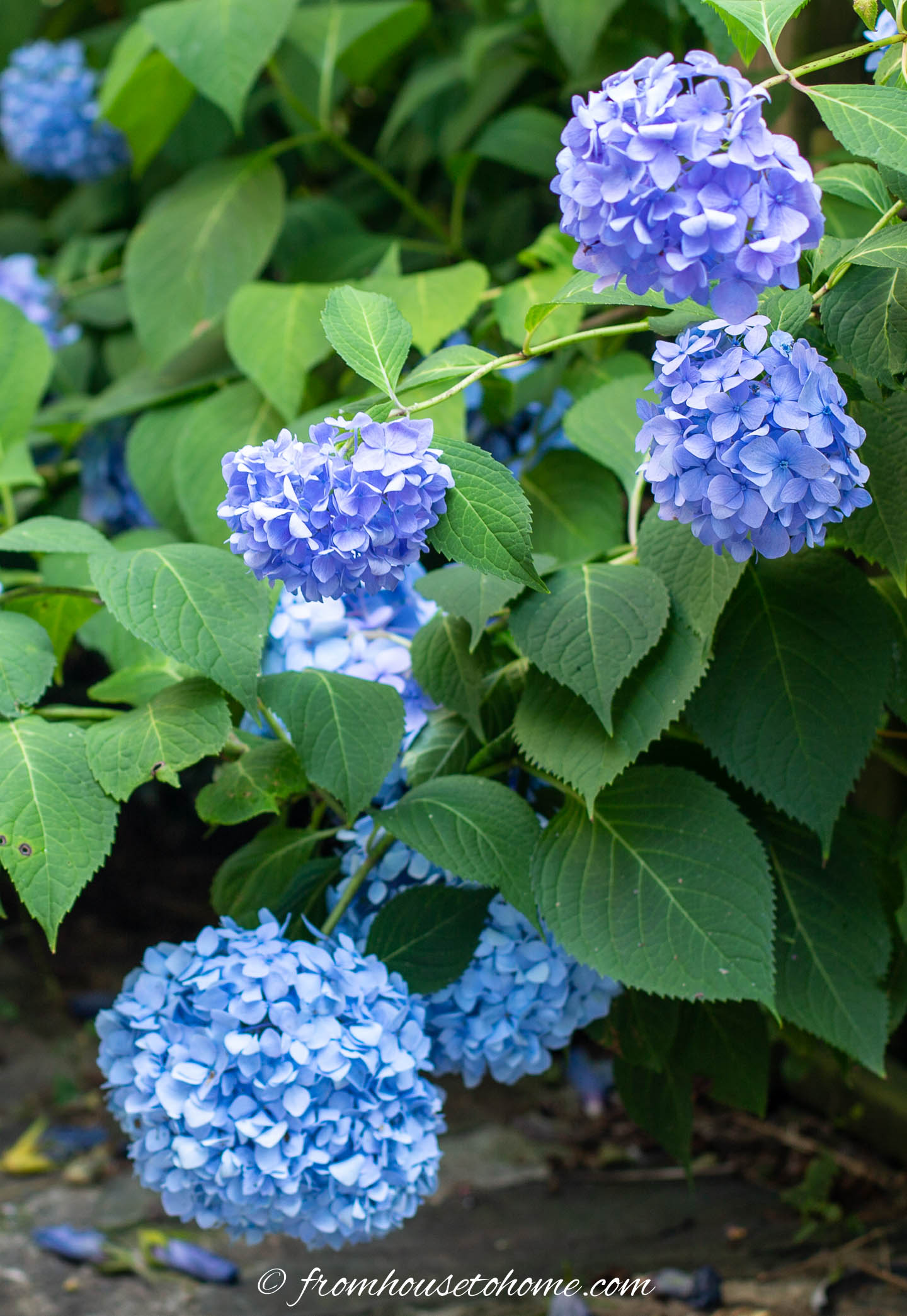
The mophead variety has clusters of showy sterile florets that form large round balls.
These flowers can bloom for 3 to 6 months from summer until the cooler weather of fall sets in.
Lacecap Hydrangea

The lacecap variety has flatter flower heads that look more delicate. The blooms are made up of sterile florets that look like buds in the center, surrounded by showy sterile florets that open wide.
The flowers on lacecap Hydrangeas last about 1 month, usually fading faster than their mophead cousins.
Common varieties:
- Blushing Bride – mophead with white to pink flowers that blooms on new and old wood. Buy it HERE.*
- Nikko Blue – mophead with bright blue flowers that blooms on old wood (it will be pinker in alkaline soil). Buy it HERE.*
- Endless Summer – mophead with blue flowers in acidic soil or pink flowers in alkaline soil that blooms on new and old wood. Buy it HERE.*
- Twist-n-Shout – the very first reblooming lacecap with blue flowers in acidic soil or pink flowers in alkaline soil that blooms on new and old wood. Buy it HERE.*
- Cherry Explosion – cherry red lacecap flowers with burgundy fall color. Buy it HERE.*
2 | Hydrangea serrata – Mountain Hydrangea

Zones: 5 to 9
Light: Partial shade
Bloom Time: Summer
Height: 2′ to 4′
Spread: 2′ to 4′
Color: Pink, red, blue
Blooms on: Old wood (all varieties), and new wood (some newer varieties such as Tuff Stuff™)
Mountain Hydrangeas are very similar to the lacecap varieties of big leaf Hydrangeas but don't grow as big.
Hydrangea serrata blooms on old wood just like Hydrangea macrophylla, but being a mountain Hydrangea, they have better bud hardiness. So they are less likely to be affected by late frosts.
Like Hydrangea macrophylla, the flowers can change color from pink to blue (and vice versa) depending on the acidity of your soil. (They turn blue in more acidic soil and pink in more alkaline soil).
The compact nature of this Hydrangea makes it a good choice for growing in containers.
Identification

As I mentioned above, Hydrangea serrata looks like a compact version of a lacecap Hydrangea macrophylla.
They have smaller leaves and grow to a smaller size.
But they could easily be confused with a young Big Leaf Hydrangea. So identifying them can be a bit of a challenge.
Fortunately, they also have the same growing and care requirements as their bigger cousins so it won't cause any problems if you treat them as such.
Common varieties:
- Tuff Stuff™ – reblooming mountain Hydrangea with pink or blue flowers (depending on the soil pH). Buy it HERE.*
- Tuff Stuff™ Red – deep pink and green flowers or purple and blue flowers (depending on the soil pH). Buy it HERE.*
3 | Hydrangea paniculata – Panicle Hydrangea
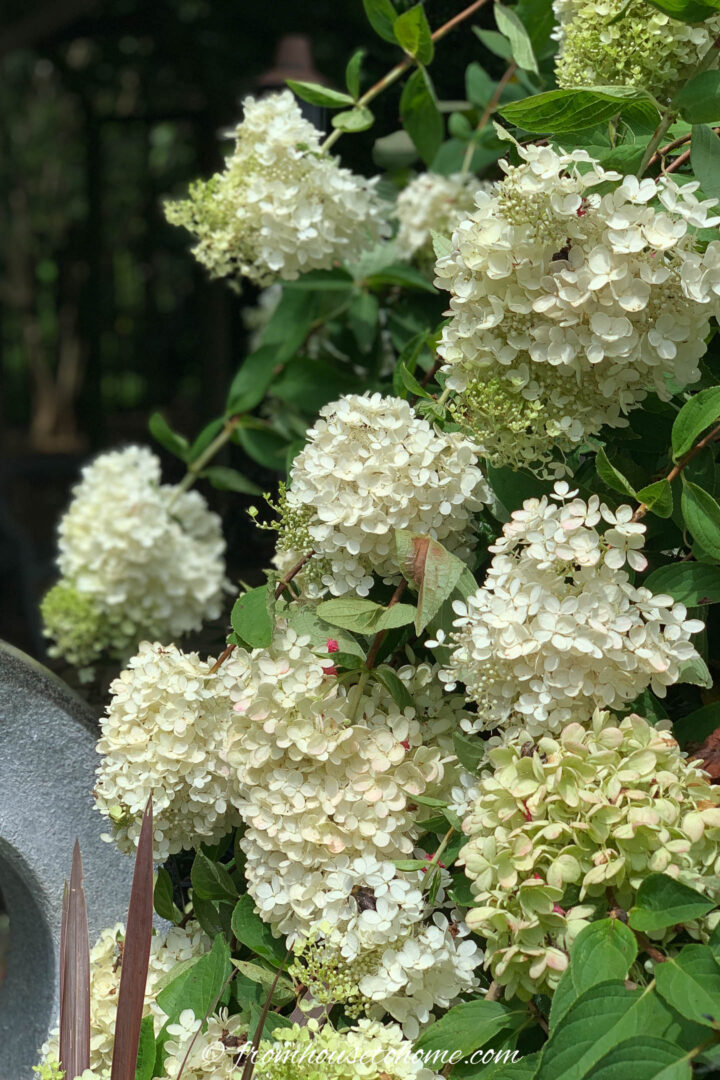
Zones: 3 to 8
Light: Full sun to part shade
Bloom Time: Summer to Fall
Height: 8′ to 12′
Spread: 8′ to 12′
Color: White, green, pink, red
Blooms on: New wood
Hydrangea paniculata is the one of the easiest and hardiest Hydrangeas to grow. Some people call it the peegee Hydrangea (also known as H. paniculata ‘grandiflora'), which is actually the original variety (there are many more available now).
It is cold-hardy (all the way down to zone 3!) and blooms on new wood only.
Which means that late frosts do not prevent it from blooming. And it can be pruned in late winter or early spring to keep its size in check.
Once established, it is more drought-tolerant than other Hydrangea types.
And does best when grown in full sun (unlike most of the others that prefer part shade).
Pannicle Hydrangeas are also available in a standard or tree form.
Identification
Hydrangea paniculata usually grows to be a much bigger bush than other types (up to 12 feet high and wide).
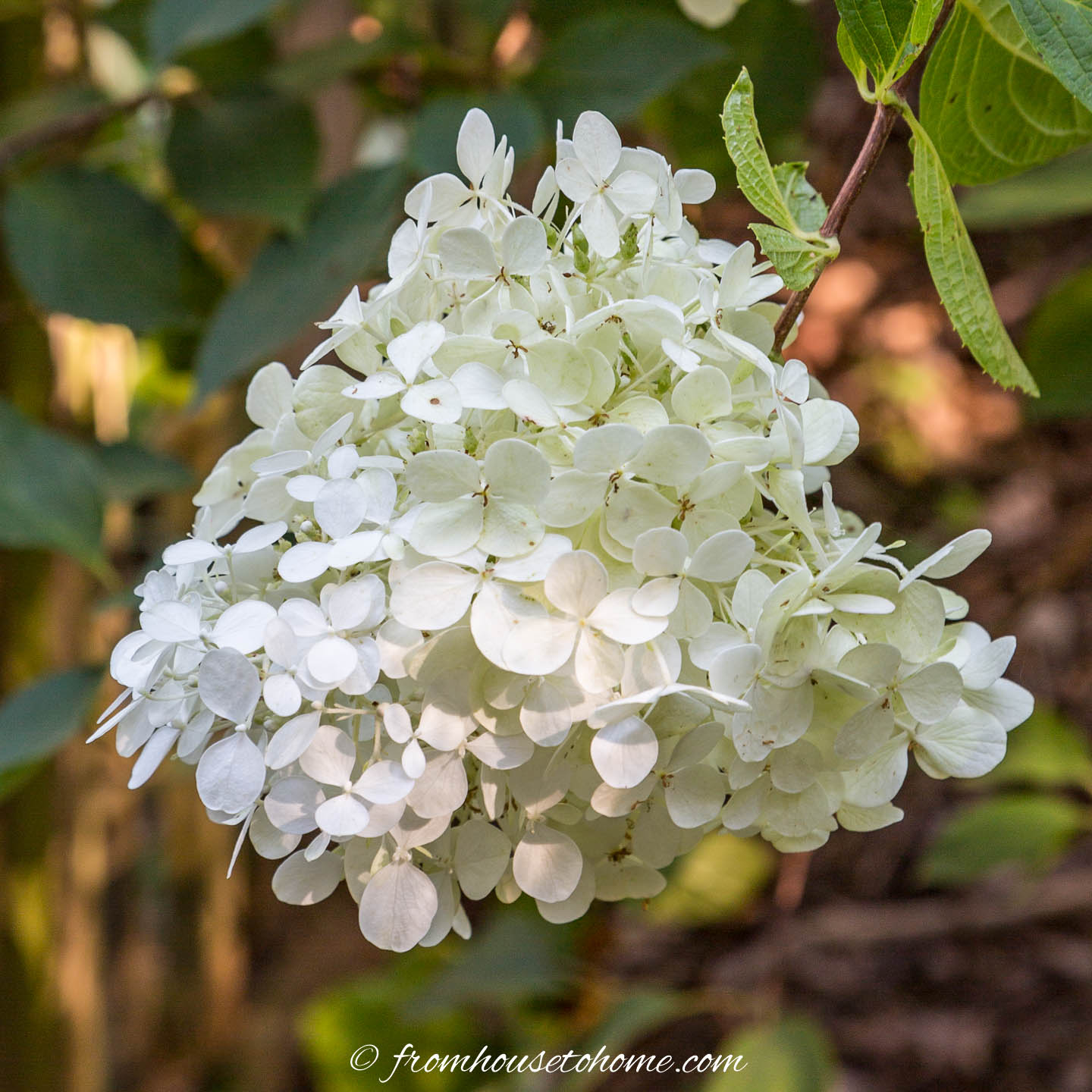
Its flowers have more of a cone shape than the ones on the big leaf hydrangea, but they are equally as showy.

They tend to start out as a white or greenish color and then turn to a shade of pink or red. The blooms will often be two-toned (part white and part pink) during the transition period.

Pannicle Hydrangeas have pointed leaves that are smaller in size than most other Hydrangeas.
The structure of Hydrangea paniculata is more like a traditional bush, with woody stems and branches (especially after it has been growing for a couple of years).
Common varieties:
- Limelight – starts green and turns to creamy white before taking on a pinkish tone towards the end of summer. Buy it HERE.* You can also get it in tree form HERE.*
- Vanilla Strawberry – starts out white and then turns to a bright pink color. Buy it HERE.*
- First Editions® Berry White® – starts white then turns pink and then red. Buy it HERE.*
4 | Hydrangea arborescens – Smooth Hydrangea

Zones: 3 to 9
Light: Part shade to sun
Bloom Time: Summer to Fall
Height: 3′ to 5′
Spread: 3′ to 5′
Color: White, pink
Blooms on: New wood
Hydrangea arborescens is a native species of Hydrangea that grows wild across much of the United States.
It is unique among these Hydrangea types in that it can survive in many different climates, from very cold to quite warm.
Many people refer to it as the Annabelle Hydrangea because it used to be the only garden variety you could find. But due to its popularity, there are a number of other smooth Hydrangeas available now that provide more selection in color and size.
This hydrangea blooms on new wood and is one of the hardiest Hydrangeas.
Identification
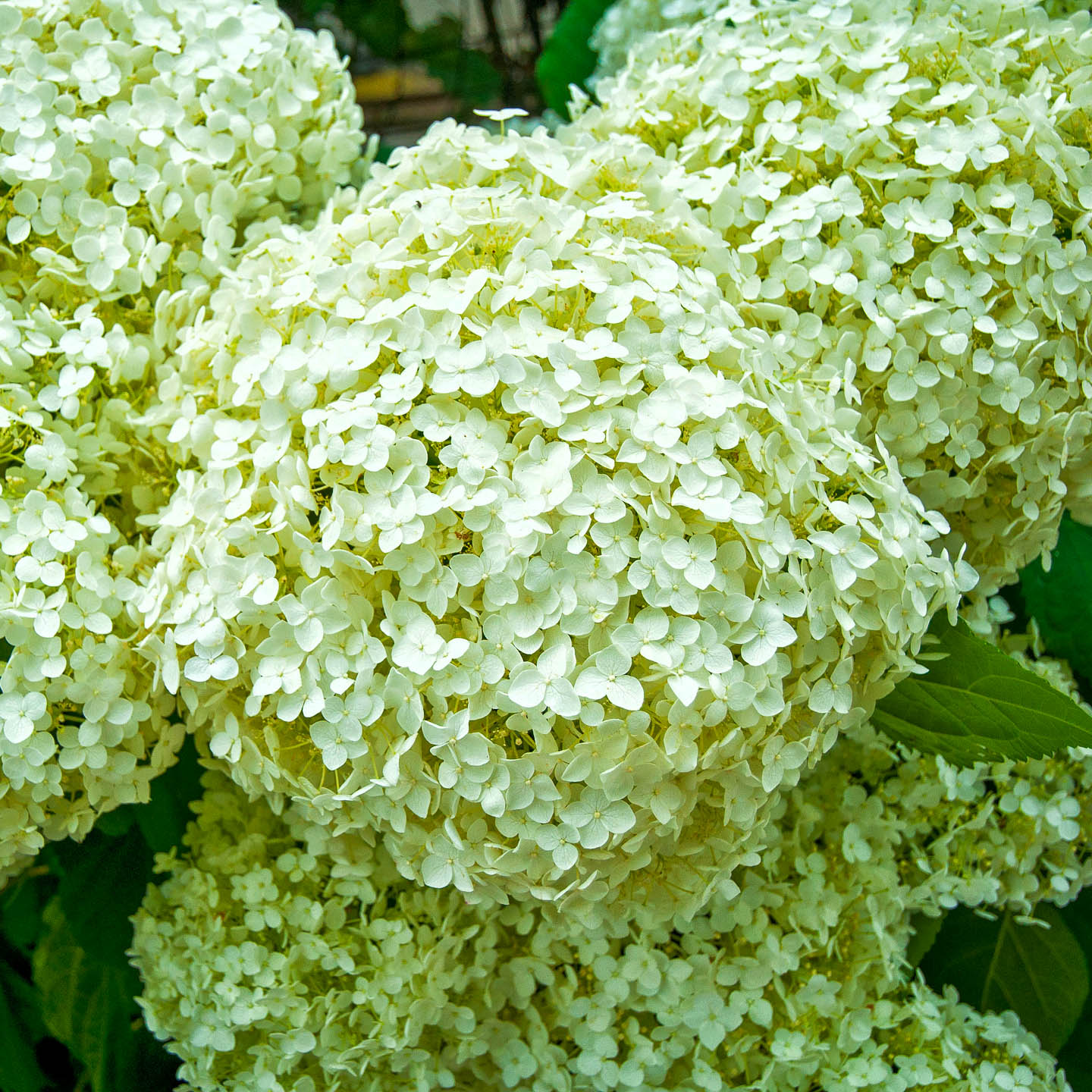
Although the native version has relatively small flowers, most cultivated Smooth Hydrangeas have huge ball-like flowers in white or pink.
The blooms are similar in shape to the Hydrangea macrophylla mopheads but are usually larger, and do not change color with changes in soil pH.

The leaves are heart shaped (rather than pointed) and have a coarser matte texture than the the big leaf Hydrangea.
They are also a lot hardier. So if you live in zones 3 or 4 and have a thriving Hydrangea with big ball flowers, chances are it's Hydrangea absorescens.
Common varieties
- Annabelle – the original Hydrangea arborescens with huge white balls for flowers. Buy it HERE.*
- Invincibelle® Ruby – burgundy red flowers on a compact plant. Buy it HERE.*
- Incrediball® – huge white flowers on sturdy stems. Buy it HERE.*
- Incrediball® Blush – huge pale pink flowers on sturdy stems. Buy it HERE.*
5 | Hydrangea quercifolia – Oakleaf Hydrangea
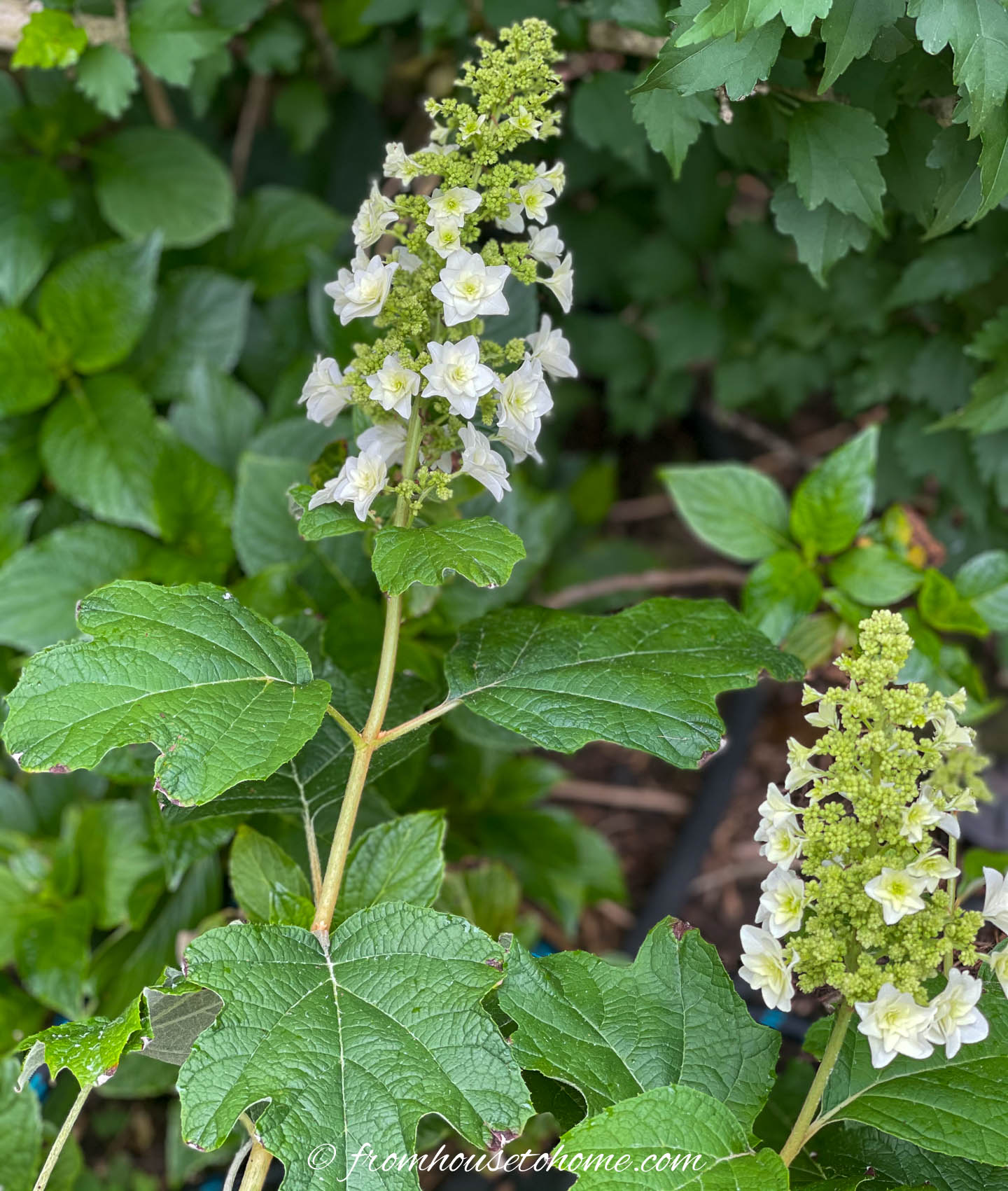
Zones: 5 to 9
Light: Full sun to part shade
Bloom Time: Summer to Fall
Height: 5′ to 8′
Spread: 5′ to 8′
Color: White, pink
Blooms on: Old wood
Oakleaf Hydrangea is another native species that is found in woodlands throughout the Southeast.
Identification

The tell-tale sign of the oakleaf variety is the shape of the leaves, which (as you may have guessed) look like oak leaves.
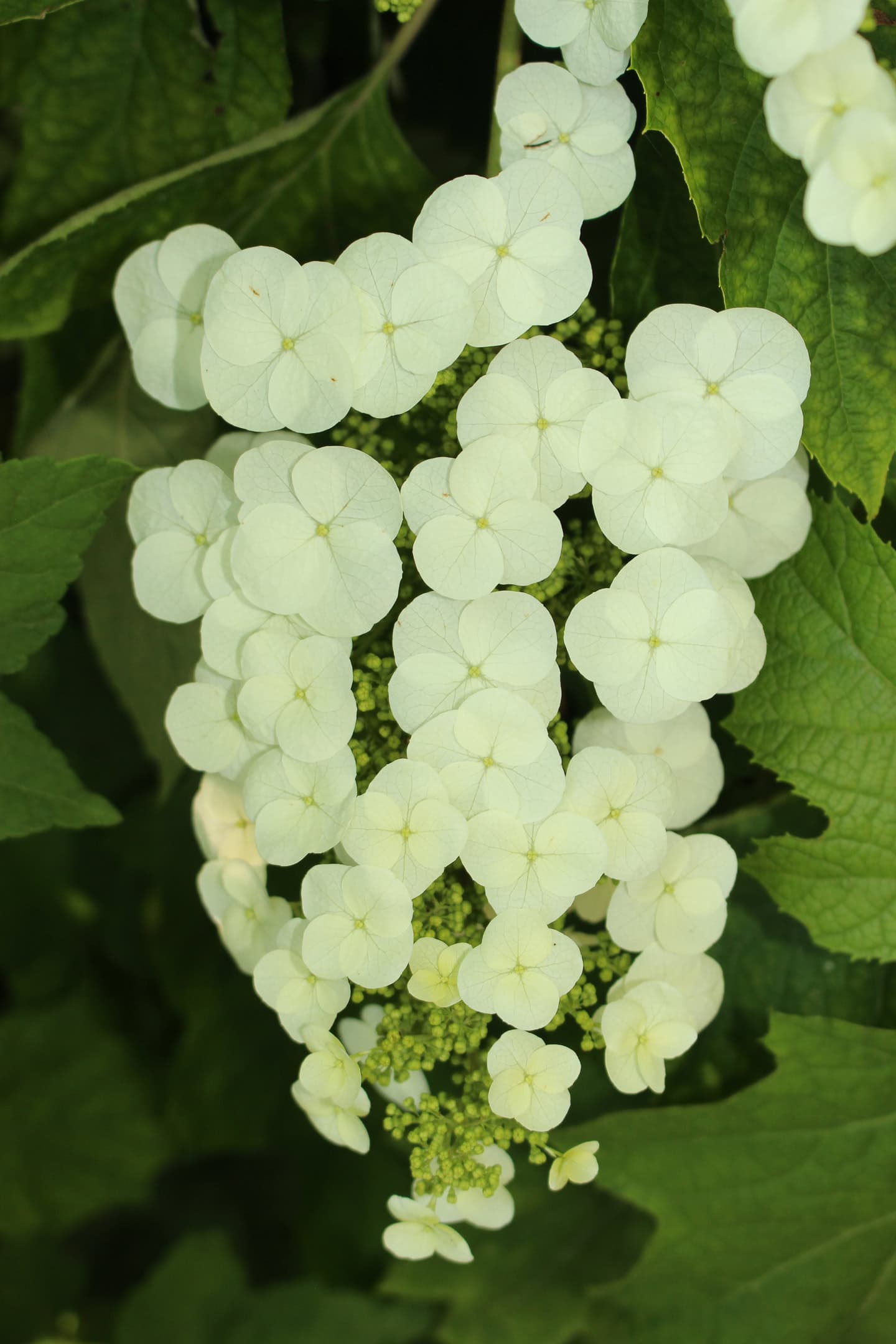
It also has oblong (rather than round) balls of flowers that are usually white or pink.

Hydrangea quercifolia also has excellent fall leaf color, turning different shades of orange, red and yellow.
Common varieties
- Gatsby Gal – 5′ shrub with greenish blooms that turn snow white. Buy it HERE.*
- Ruby Slippers – white blooms that turn pink then red. Buy it HERE.*
- Alice – native cultivar with foot-long flowers that start white and age to pink. Buy it HERE.*
6 | Hydrangea petiolaris – Climbing Hydrangea

Zones: 4 to 9
Light: Part to full shade
Bloom Time: Spring to Summer
Height: 30′ to 40′
Spread: 6′ to 8′
Color: White
Blooms on: Old wood
Hydrangea petiolaris (also known as Hydrangea anomala) is a vine with beautiful, lacy white blooms. If you have a pink one, it's actually a different plant species (Schizophragma hydrangeoides) that is also often referred to as a climbing Hydrangea.
It can take some time to get going (up to 5 years!), but is a beautiful addition to the garden once it gets established.
Climbing Hydrangea can also be grown as ground cover but blooms best when grown vertically.
Identification

There's no confusing climbing Hydrangeas with any of the other kinds. It's a vine.
They have long stems with sticky pads that hold them up on the sides of walls and fences, and grow to 30 or 40 feet long.
The flowers are white and lacy-looking, something like a lacecap Hydrangea macrophylla.
Common varieties
- There aren't many different varieties that are actually in the Hydrangea family. But you can it HERE.*
Hydrangea identification chart

As a quick summary, this decision tree will help you identify what type of Hydrangea you have.
Of course, there are always exceptions but it will work for most cases.
Commonly Asked Questions
Which Hydrangeas grow in full sun?
Hydrangea paniculata and Hydrangea quercifolia are the best varieties to grow in full sun, although Hydrangea aborescens can do well there if it is kept well watered.
Which Hydrangeas grow in the shade?
Hydrangea petiolaris (climbing Hydrangea), Hydrangea macrophylla, Hydrangea quercifolia, Hydrangea aborescens and Hydrangea serrata will all grow in the shade, but most will bloom best in partial rather than full shade.
What types of Hydrangeas bloom on new wood?
Hydrangea paniculata and Hydrangea aborescens are the two Hydrangeas that bloom entirely on new wood. Some other reblooming varieties, such as the ‘Endless Summer' Hydrangea macrophylla and the ‘Tuff Stuff' Hydrangea serrata cultivars bloom on both old and new wood.
What types of Hydrangeas bloom on old wood?
Hydrangea petiolaris (Climbing Hydrangea), Hydrangea quercifolia, Hydrangea serrata and Hydrangea macrophylla all bloom on old wood and should not be pruned in the fall or spring to prevent cutting off the buds.
Other Hydrangea tips you might like
Or browse all of our tree and shrub ideas.
Have comments or questions about the types of Hydrangeas (and how to identify them)? Tell us in the section below.
Pin It So You Don't Forget It!

This post was originally published on October 6, 2021 but was updated with new content on November 23, 2024.



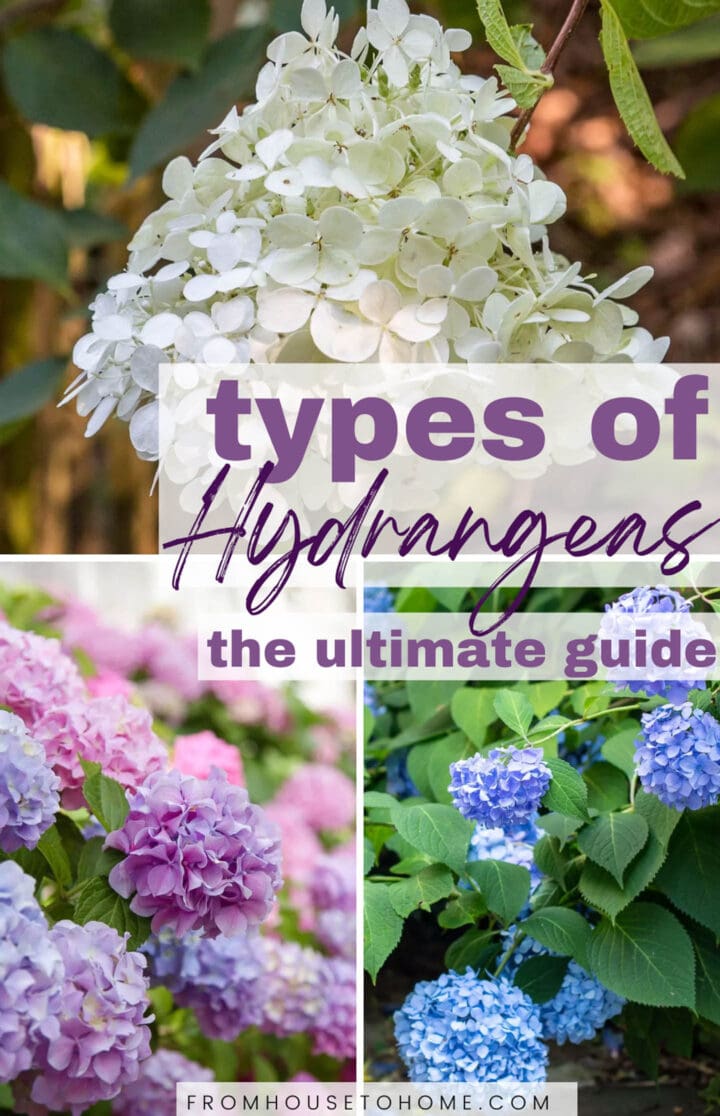












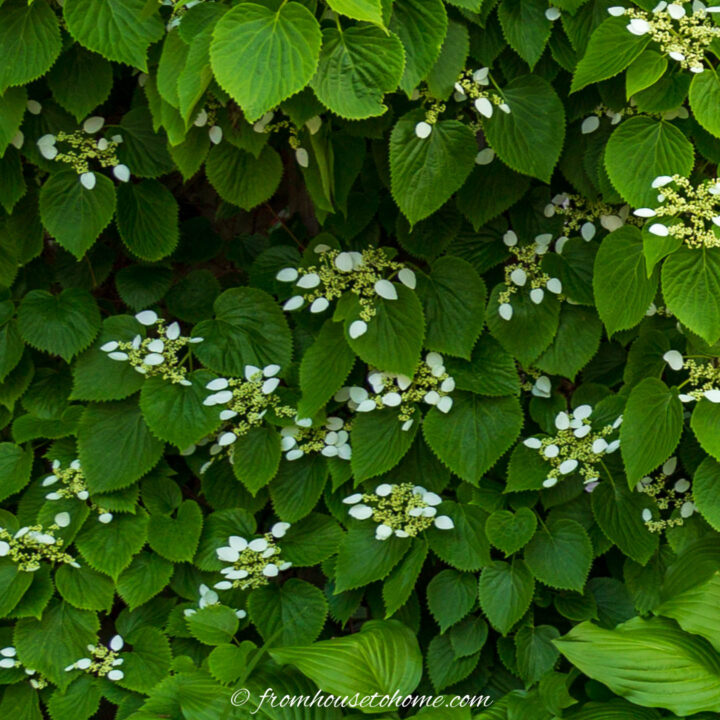

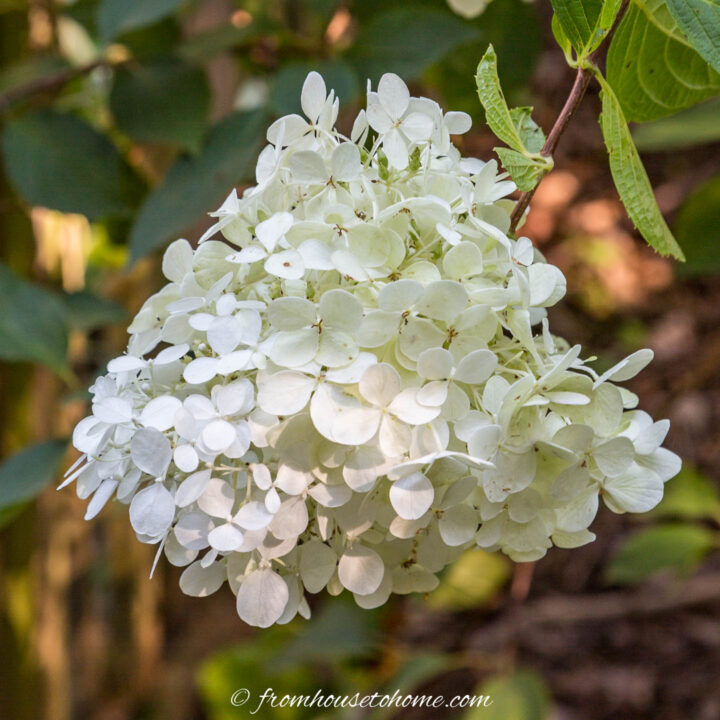



I am interested in a hydrangea which will bloom in full shade to 1 hour morning sun and 1 hour of evening sun that is evergreen (holds leaves throughout winter). Is there a hydrangea that would work in this scenario? I am in zone 7 (Atlanta, Georgia).
Any suggestions would be much appreciated!
Thanks!
Hi Karen…I am not aware of any evergreen Hydrangeas. Hydrangea macrophylla would probably be the best for shady conditions (although you may get fewer blooms with that much shade).
Is there a Hydrangea that can grow in Florida, zone 9?..Thank you.
Hi Thomas…You should be able to get varieties of Hydrangea paniculata, Hydrangea macrophylla and Hydrangea quercifolia that will do well in zone 9. They’ll do fine in the heat as long as they are well-watered.
Such a informative post! I had no idea there were so many different types of hydrangeas. Learning about their unique characteristics and how to identify them has inspired me to add some to my garden. Thank you for sharing!